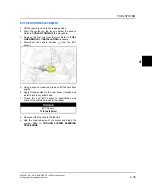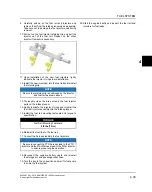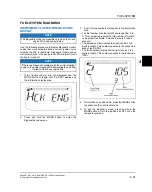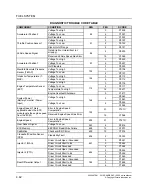
4.46
9928487 R01 - 2018 RANGER XP 1000 Service Manual
© Copyright Polaris Industries Inc.
CYLINDER MISFIRE DETECTION
NOTE
This process only applies to some MY15 and later
models.
Refer to this procedure only if one of the codes shown
below is displayed in Digital Wrench.
The ECU monitors crankshaft speed via the crankshaft
position sensor. A misfire will cause a fluctuation in
crankshaft speed. A code will set and turn on the check
engine light after an engine misfire threshold/rate is
detected that is above a pre-determined limit. This
threshold varies based on engine speed.
One or more of the following codes will be set if a misfire
occurs:
• P0301 (SPN 65591/FMI 7) Misfire Detected, Cylinder
1 (MAG)
• P0302 (SPN 65592/FMI 7) Misfire Detected, Cylinder
2 (PTO)
• P0314 (SPN 65590/FMI 7) Misfire Detected, Cylinder
Not Identified
Once a cylinder misfire code is set, the following events
will occur:
• Check Engine Light illuminates
• If the cylinder can be detected by the ECU (code
P0301 or P0302), the ECU will deactivate the fuel
injector for that cylinder. This will remain in effect until
the key is cycled off and back on.
• If the cylinder with the misfire cannot be detected
(code P0314), the ECU will limit available power by
limiting how far the throttle plate opens.
One the key is cycled, the trouble code (s) will show
current but there will be no fuel injector deactivation or
throttle limitation unless the misfiring continues to occur.
The check engine light will remain illuminated until there
are 4000 engine revolutions (i. e. 4000 RPM for one
minute) without a significant misfire being detected.
Once this condition is met, the check engine light will turn
off and the code(s) will show as historic.
If a misfire code has been set and there is no observed
misfire, cycle the key and allow 4000 engine revolutions
to see if the check engine light turns off. If it does not turn
off, diagnose by verifying the following items:
• Low battery voltage (loose connection, low charge,
bad battery)
• Faulty voltage regulator
• Ignition Coil and connections are good
• Spark plugs wires are secure
• The correct spark plugs are installed and the plugs are
not fouled
• Crankshaft Position Sensor tests good
• Wiring to the Crankshaft Position Sensor, ECU and
Ignition Coil are not damaged. Chassis ground is clean
and tight
• Fuel pressure is within specification
• Fresh/good quality fuel is in the fuel tank
• Engine mechanical is good (leak down, timing)
• Confirm the belt is in good condition, specifically
looking for signs of hour-glassing
• Confirm primary clutch operation (worn/incorrect
weights, loose spider/jam nut)
• Confirm secondary clutch operation (sliders, rollers,
helix)
















































